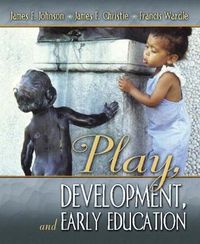
spara 50%
1 säljare
Play, Development and Early Education Upplaga 1
Most chapters begin with “Introduction” and “Focus Questions” and conclude with “Summary” and “Projects/Assignments.”I. THE IMPORTANCE OF PLAY.
1. Beliefs About Play.
History and Images of Children and Play.
Multiple Perspectives on Play.
Defining Play.
Current Issues and Trends.
2. Theories of Play.
Classical Theories
Modern Theories
Postmodern Theories
Implications for Teachers
II. PLAY AND DEVELOPMENT.
3. Play, Development, and Assessment: Birth to Eight Years.
Play Development: An Overview.
Development of Motor Play.
Development of Object Play.
Development of Symbolic Play.
Development of Social Play.
Play Development from Six to Eight.
Play Assessment.
4. Diversity and Individual Differences in Play.
Gender Differences.
Physical Play.
Personality and Play.
Race and Ethnicity.
5. Play's Role in Development.
Play and Development: Basic Observations.
Brain Development and Play.
Cultural Learning and Play.
Language and Literacy Dimension.
Feature: School Readiness: Educational Value of Play.
Social Dimension.
Feature: What good is play? Communicating the value of play to parents.
Emotional Dimension.
6. Play Contexts: Physical Environment, Social Ecology, and Culture.
Cultural-Contextual Approaches to Play.
Physical Environment and Play.
Social Ecology and Play.
Play and Culture.
Educational Applications.
III. PLAY AND EDUCATION.
7. Play's Role in Education.
The value of educational play.
Types of Educational Play.
Barriers to educational play.
8. Enriching Classroom Play: Materials and Curriculum.
Relationship between play materials and development.
Characteristics of play materials.
Types of Play Materials.
9. Enriching Classroom Play: Teaching Strategies and Facilitation Techniques.
Providing Adequate Time for Play.
Preparatory Experiences.
Teacher Involvement in Play.
Linking Play with Instruction.
10. Play for Children with Special Needs and Circumstance.
Play and Special Education.
Play Therapy.
Child Life Programs.
11. Popular Culture, Media, and Technology.
Popular Culture.
Play and the Media.
Technology.
12. Outdoor Play.
History of Playgrounds.
Purpose of outdoor play.
Different kinds of playgrounds.
Playground design.
Age-related playgrounds.
Safety.
ADA Accessibility.
Role of the teacher in the playground.
Outdoor play advocacy.
Upplaga: 1a upplagan
Utgiven: 2004
ISBN: 9780205394791
Förlag: Pearson
Format: Häftad
Språk: Engelska
Sidor: 448 st
Most chapters begin with “Introduction” and “Focus Questions” and conclude with “Summary” and “Projects/Assignments.”I. THE IMPORTANCE OF PLAY.
1. Beliefs About Play.
History and Images of Children and Play.
Multiple Perspectives on Play.
Defining Play.
Current Issues and Trends.
2. Theories of Play.
Classical Theories
Modern Theories
Postmodern Theories
Implications for Teachers
II. PLAY AND DEVELOPMENT.
3. Play, Development, and Assessment: Birth to Eight Years.
Play Development: An Overview.
Development of Motor Play.
Development of Object Play.
Development of Symbolic Play.
Development of Social Play.
Play Development from Six to Eight.
Play Assessment.
4. Diversity and Individual Differences in Play.
Gender Differences.
Physical Play.
Personality and Play.
Race and Ethnicity.
5. Play's Role in Development.
Play and Development: Basic Observations.
Brain Development and Play.
Cultural Learning and Play.
Language and Literacy Dimension.
Feature: School Readiness: Educational Value of Play.
Social Dimension.
Feature: What good is play? Communicating the value of play to parents.
Emotional Dimension.
6. Play Contexts: Physical Environment, Social Ecology, and Culture.
Cultural-Contextual Approaches to Play.
Physical Environment and Play.
Social Ecology and Play.
Play and Culture.
Educational Applications.
III. PLAY AND EDUCATION.
7. Play's Role in Education.
The value of educational play.
Types of Educational Play.
Barriers to educational play.
8. Enriching Classroom Play: Materials and Curriculum.
Relationship between play materials and development.
Characteristics of play materials.
Types of Play Materials.
9. Enriching Classroom Play: Teaching Strategies and Facilitation Techniques.
Providing Adequate Time for Play.
Preparatory Experiences.
Teacher Involvement in Play.
Linking Play with Instruction.
10. Play for Children with Special Needs and Circumstance.
Play and Special Education.
Play Therapy.
Child Life Programs.
11. Popular Culture, Media, and Technology.
Popular Culture.
Play and the Media.
Technology.
12. Outdoor Play.
History of Playgrounds.
Purpose of outdoor play.
Different kinds of playgrounds.
Playground design.
Age-related playgrounds.
Safety.
ADA Accessibility.
Role of the teacher in the playground.
Outdoor play advocacy.
Begagnad bok
799 kr1592 krSpara 793 kr (50%) mot nypris
Fri frakt & skickas inom 1-3 vardagar
Köpskydd med Studentapan
Varje köp täcks av Studentapans köpskydd som säkerställer att boken kommer fram, att du får rätt bok och att skicket stämmer överens med beskrivning.



